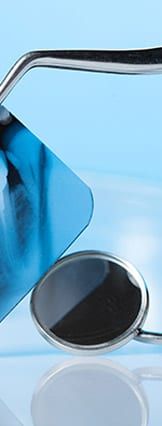Dental Cleaning & Consultation
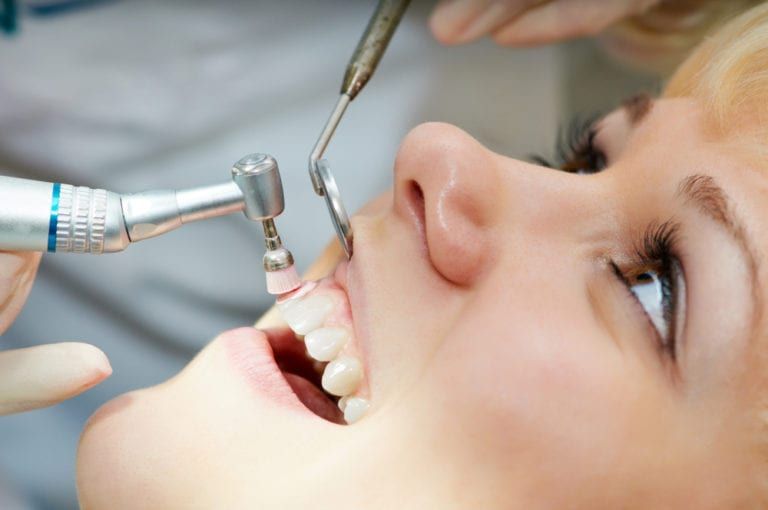
Preventative care is a foundation of dentistry. The American Dental Association recommends visiting your dentist regularly – usually about twice yearly – for full cleanings, examinations, and consultations for potential treatment. Professional dental cleanings help remove built-up plaque that is not removable using conventional brushing and flossing. Often, dentists are also capable of identifying potential problems that patients are not yet able to see or feel. When you maintain regular preventative dental appointments, you can stave off decay and gum disease, as well as identify the beginnings of oral health problems before they become severe.

Did you know…that Americans are less and less likely to visit the dentist as they age? Data from the Centers for Disease Control reports that only 57 percent of Americans over age 65 visited the dentist in 2010. That compares to about 61 percent adults under age 65 and about 79 percent of children ages 2 to 17. Nonetheless, it is important to visit the dentist for cleanings and exams regardless of how long has passed since your most recent dental appointment.
Frequently Asked Questions
Do I really need to have my teeth professionally cleaned?
Yes. Even if you brush and floss after every meal and before bed, bacteria-harboring plaque can accumulate in the tiniest crevices, grooves and pits. Overtime, the teeth will begin to decay in those areas, which may result in pain and partial or total tooth loss.
What should I expect at my cleaning and exam consultation?
Your cleaning and consultation will consist of a visible examination of the teeth and gums. If you haven’t been to the dentist in a while, you may also require x-rays for a more comprehensive view of your teeth. You’ll also consult with your dentist about any oral health problems you may have been having or questions that you may have. The cleaning will follow, during which a dental hygienist will use special instruments to remove hardened plaque from your teeth. Finally, your teeth will be polished before your dentist discusses any treatment recommendations he or she may have for you.
What types of guidelines should I follow after my visit?
In between dental cleanings and consultations, be sure to maintain good oral habits at home. This includes daily flossing and brushing after meals. It’s also important to drink fluoridated water and use a fluoridated toothpaste.
Composite Fillings
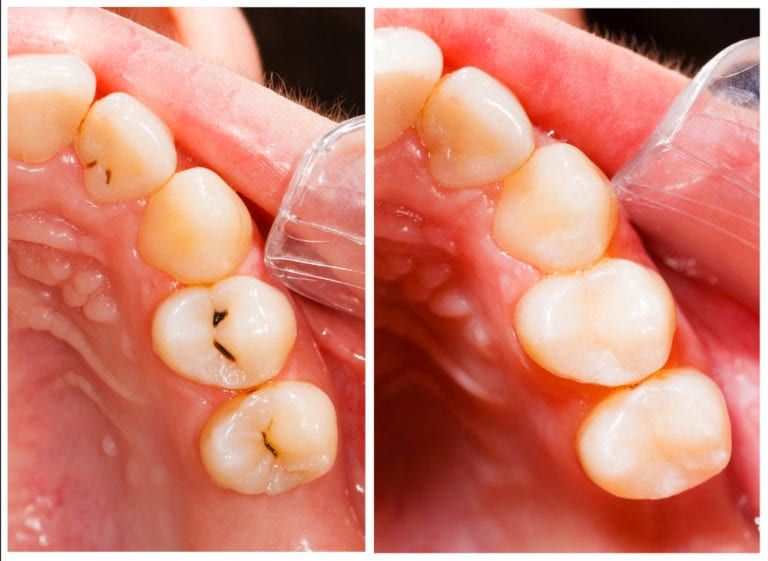
Composite fillings, also known as tooth-colored fillings, are dental restorations designed to be inconspicuous and natural in appearance. They blend well with the teeth and appear more natural than amalgam fillings, which are darker and more visible. Composite fillings can be used to fill in decayed areas of the teeth, as well as to help repair chipped or broken teeth. Most dentists use composite restorations to treat the teeth closest to the front of the mouth, as they are more noticeable when patients smile. However, advancements in dental technology and the composition of composite fillings have made it possible for Dr. Main to also use tooth-colored fillings on molars, which receive more wear than other teeth.
Did you know…
that composite fillings allow dentists to preserve more of the natural tooth structure? This is because composite materials chemically bond to the surface of the tooth like an adhesive. The process takes slightly longer to complete than traditional amalgam fillings, but patients can preserve more of the natural portion of the teeth while enjoying a restoration that is discreet and understated.
Frequently Asked Questions
Am I a candidate for tooth-colored fillings?
If you have a cavity, broken tooth, or a deteriorated filling, you may be a candidate for a tooth-colored filling. Schedule a dental consultation to find out if a composite filling is right for you.
What should I expect if my dentist decides a composite filling is right for me?
During your visit, your gums and teeth will be anesthetized with a local anesthetic near the site of the filling. Once the area is numb, the decayed or damaged portion of your teeth will be removed. A series of steps are used to ensure that the composite bonds to the tooth, and then the composite is added to replace the missing tooth structure. The new filling will then be shaped and polished before the procedure is complete.
What type of post-treatment care is required after getting a composite filling?
You should be able to return to normal activity and oral care immediately after your visit. It is normal to experience cold sensitivity following the placement of a composite filling. A quick “zing” with ice water, ice cold pop or ice cream is normal and will improve with time.
Amalgam Fillings
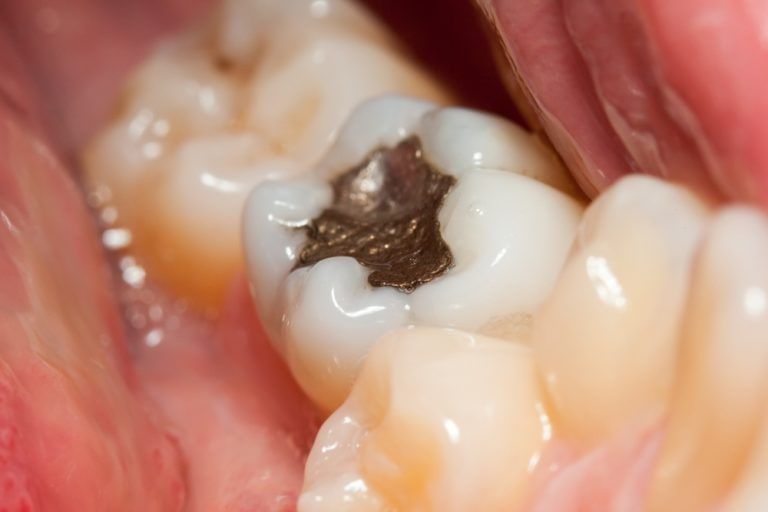
Amalgam is an economical blend of metals used to fill cavities in the mouth. Also known as ‘silver fillings’, amalgam fillings are comprised of silver, copper, mercury and tin. The majority of Americans have dental fillings – most of whom have at least one amalgam. Many prefer amalgam because it is the most affordable and long-lasting filling material available today. In fact, amalgam fillings are less likely to fall out or break than other filling material.
Did you know…
that amalgam has been the filling material of choice for millions of dental patients over the past 150 years? It remains a commonly used filling material today, with the Food and Drug Administration ruling it safe for dental patients age 6 and up. Amalgam can be placed in a single visit and is made to be self-sealing – resisting the development of further decay.
Frequently Asked Questions
Am I a candidate for amalgam fillings?
Nearly anyone with tooth cavities over the age of 6 is a candidate for amalgam fillings. However, the decision to get silver fillings can only be made between you and your dentist. Be sure to tell your dentist if you have any metal from getting an amalgam filling.
What should I expect when I get my amalgam filling?
Your dentist will numb the nerves surrounding your tooth at the start of your visit. Then, your tooth will be drilled to remove decay and prepare the surface for your filling. Amalgam is mixed at the time of filling using a combination of metal alloy and liquid mercury. Blended together, these ingredients make a putty that hardens and typically requires no follow-up visit.
How long will an amalgam filling last?
Amalgam fillings are made to withstand biting pressure and last for many years. Instances of breakage are rare, and repair frequency is low. When properly cared for, most silver fillings last a minimum of 10 to 15 years. Your dentist will check the condition of your fillings during your periodic dental exams and cleanings.
Dental Sealants
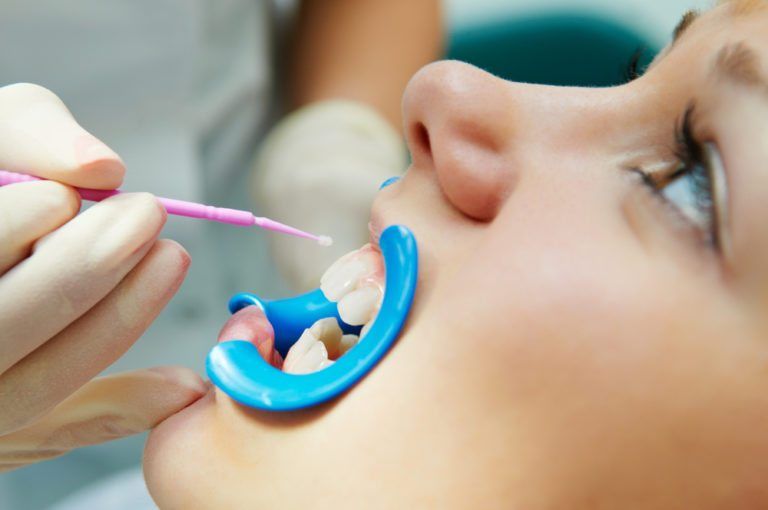
Dental sealants are clear coatings applied to the surfaces of a child’s molars to prevent the development of tooth decay. They work by preventing food and plaque from resting in the grooves and crevices of molars – an area especially susceptible to cavities. According to the National Institute of Dental and Craniofacial Research, nearly 1 in 3 U.S. children ages 6 to 12 currently have sealants on their teeth.
Did you know…
that sealants can last as long as 5 to 10 years pediatric dental patients? Depending on a child’s oral development and risk factors for tooth decay, sealants may be applied to the teeth as young as age 6. It is at this time that the first molars typically appear. Additional molars erupt at approximately age 12. If possible, sealants should be applied to a child’s teeth immediately after any molar has appeared to reduce the risk of early decay.
Frequently Asked Questions
Will dental sealants affect the feel or appearance of my child’s teeth?
Sealants bond directly to the teeth, where they harden to a clear or tooth-colored coat. This makes them virtually undetectable to others. Though it is normal to feel new sealants with the tongue, most children quickly adapt to their presence.
What will my child experience when getting sealants?
The process of getting sealants is fast and painless. The tooth is cleaned before the dentist paints the sealant onto the enamel. The sealant will immediately harden, acting as a barrier between bacteria and the chewing surface of the teeth. In most cases, sealants will last several years before needing to be reapplied. However, regular visits to the dentist will be necessary to monitor the condition of the sealants and examine their effectiveness.
Will sealants prevent all cavities?
While sealants are extremely effective for preventing tooth decay in children, they do not replace other forms of preventative oral health care. Children should still brush and floss each day using a fluoridated toothpaste. Regular dental exams and a balanced diet low in sugar are also essential for good long-term oral health.
Crowns and Bridges

Dental crowns and bridges are custom-fitted tooth prosthetics that are used to replace or restore damaged or missing teeth. Crowns, also known as “caps”, are fixed over the surfaces of natural tooth structures or dental implants. Bridges are used to fill in the gaps left by missing teeth and are anchored in place by the natural teeth on either side of the empty space. Both crowns and bridges are permanent, they may not be taken in and out of the mouth. Patients who choose a crown or a bridge to restore their smile achieve both the function and appearance of natural, healthy teeth.

Frequently Asked Questions
Is a crown or bridge right for me?
If you have a tooth that is damaged or decayed, but still intact, a crown may be right for you. If your tooth is missing, but its former position is surrounded by other tooth structures, a bridge may be the solution for you. Schedule an office consultation to determine whether you could benefit from crowns or bridges.
What should I expect when I choose to have a crown or bridge?
You should expect to be scheduled for two appointments. The first appointment entails shaping the tooth in such a way that a crown will fit over it. When the desirable shape has been achieved, a final impression will be made. This impression is then sent to a dental lab here in Des Moines where your permanent crown will be made. Most crowns are made and returned to our office in about a week. At the end of your first appointment, a temporary crown will be made. You will wear this temporary crown until you return for your second appointment, when the permanent crown is permanently cemented in to place.
Do I need to follow any post-treatment care guidelines?
It is normal to experience some cold sensitivity after you receive dental treatment. A quick “zing” with ice cold water, pop or ice cream is normal, and will remind you of the work you have had done.
Temporary crowns are kept in place on the tooth with temporary cement. Anything that is sticky or chewy, may pull the temporary crown off. It is advised to stay away from sticky or chewing foods and gum until the permanent crown is cemented in place.
Dental Implants
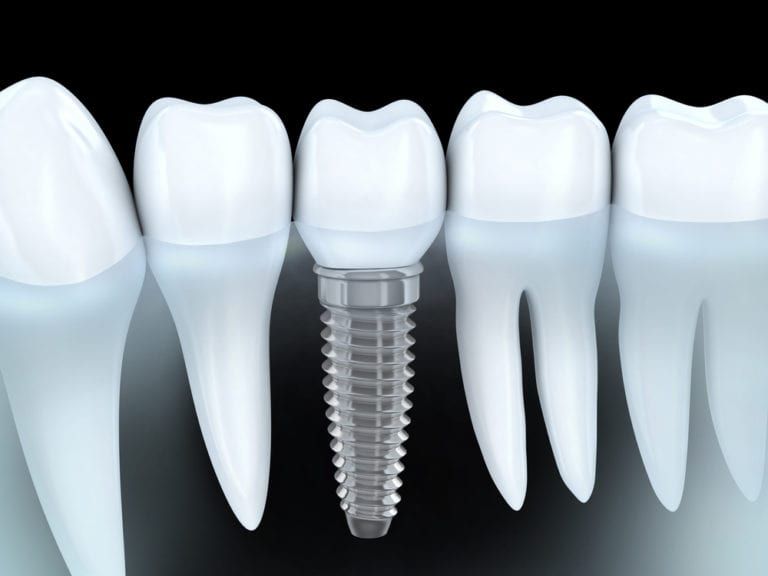
Dental implants are surgical-grade root devices that support permanent tooth prosthetics that are manufactured to last a lifetime. These artificial roots are anchored in the bone beneath the gums where they become fused into the jaw. A crown is mounted atop the implant for a long-lasting and natural looking smile. Many dentists and patients prefer dental implants because they offer the same function as natural teeth and also help prevent bone atrophy in the jaw. Dental implants may be used to replace a single missing or damaged tooth or to restore an entire smile.
Did you know…
that approximately 30 million people live with no natural teeth in one or both jaws? But more and more dental patients are opting for dental implants as a means of tooth replacement. The American Academy of Implant Dentistry reports that 3 million people currently have dental implants – a number that is rapidly growing by about 500,000 per year. Modern titanium implants were first developed in the 1950’s, but archeologists have determined that ancient Egyptians and Mayans were the first cultures to implant artificial teeth.
Frequently Asked Questions
Are dental implants right for me?
You may qualify for dental implants if you have missing, broken or severely decayed teeth and are in relatively good overall health. The only way of determining your eligibility for implants is to consult with an oral care provider to identify whether you have adequate bone support and healthy gums that will support the new tooth structure.
What should I expect if my dentist and I decide dental implants are right for me?
The placement of dental implants is a multi-step process that typically takes between 6 and 9 months to complete. It begins with a surgical procedure during which a titanium rod is placed where a previous natural tooth root once was. The gums are sutured shut over the implant, where is will stay for several months while it heals and begins fusing with the surrounding bone. Due to the nature of implant placement and its average procedure time of between 1 and 2 hours, you’ll be sedated and/or anesthetized for the duration of the treatment. At the conclusion of the healing period, you’ll return to be fitted for permanent crowns and have them placed.
What type of post-treatment care will I require?
It is normal to experience some discomfort, including bruising and swelling following a dental implant procedure. However, inflammation and pain may be managed with over-the-counter medications, hydrocodone, or codeine. You may be asked to eat only soft foods for approximately 2 weeks until the surgical site heals.
Tooth Extractions
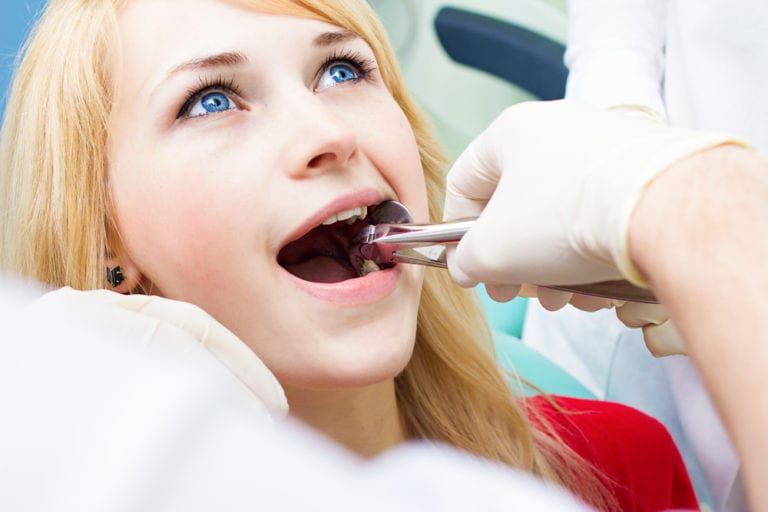
Tooth extractions are routine dental procedures used to remove decayed, damaged or otherwise problematic teeth. Dentists usually make every effort to preserve natural teeth, although sometimes an extraction is necessary. Although the procedure is performed in a dentist’s or oral surgeon’s office, it is considered surgery. Depending on which teeth are removed, they may be replaced with a dental implant or another oral prosthetic.
There are several reasons why you could need a tooth extraction.
The most common cause of tooth extractions is severe tooth decay and cavities. However, many patients also undergo extractions for impacted teeth – particularly wisdom teeth. Other causes for extraction include advanced periodontal disease, cracked teeth, and teeth that are severely malformed. Although many circumstances that require extraction are unavoidable, some could be prevented with regular visits to the dentist for exams and cleanings.
Frequently Asked Questions
Do I need a tooth extraction?
Only your dentist can tell you if you need a tooth extraction. However, you may be a candidate for the procedure if one or more of your teeth are decayed so severely that a filling or others restoration is not a possibility for treatment.
What should I expect during my tooth extraction appointment?
If you and your dentist decide to extract one or more teeth, you will be scheduled to return for oral surgery at a later date. You will be given a local anesthetic to prevent pain during the procedure, and you may be prescribed medications to help manage pain in the hours following your extraction. Depending on the nature of your extraction and other factors, such as whether your teeth are impacted, you may also be sedated or given general anesthesia during your procedure.
What type of post-treatment care will I need to follow?
Post-operative care following a tooth extraction is essential for healing and preventing complications. You will be instructed to avoid certain foods and also keep the surgical site clean at all times. If you are prescribed an antibiotic, it is important that you complete the course of treatment to prevent infection. Finally, you may be advised to avoid smoking or drinking through a straw, as doing so may delay the healing process and cause a condition known as ‘dry socket.’
Root Canals
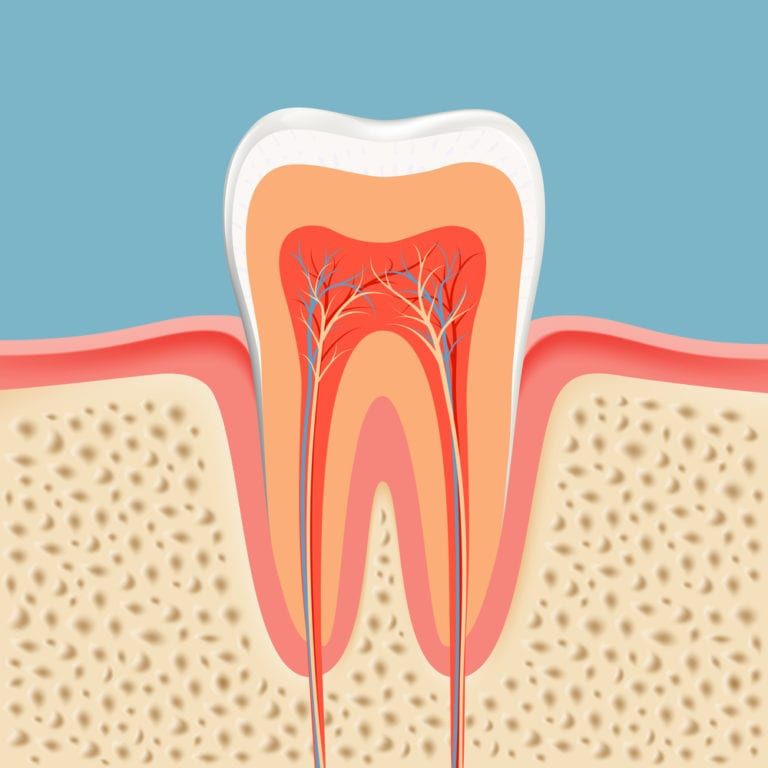
Root canals are valuable dental procedures used to treat and preserve teeth with badly infected roots. The pulp is the live portion of the tooth that extends into the root and contains nerve endings and tissues. When it becomes infected, patients can experience pain, swelling and even total tooth loss unless treated. Root canals remove the damaged parts of the tooth and infected root. In some cases, an antibiotic is prescribed to help prevent further infection within the tooth. The organic portion of the tooth that remains may be restored using a cap or crown that provides a natural appearance and normal tooth function.
Many patients associate root canals with pain and discomfort.
But local anesthetics and advancements in modern dentistry have made root canals highly tolerable procedures that are often no less comfortable than getting a standard filling. Upon completion, a restored tooth that has undergone a root canal will blend in with surrounding teeth – virtually undetectable to the average eye. More than 9 out of 10 root canal procedures are successful, and most treatments last many years or even a lifetime.
Frequently Asked Questions
Am I a candidate for a root canal?
You could be a candidate for a root canal if decay or damage has allowed bacteria to infect the pulp inside your tooth. A root canal could also be the right treatment for you if you prefer to preserve as much of your natural tooth as possible instead of extracting both the healthy and diseased portions of your tooth. For more information about root canals and whether they are right for you, schedule a dental exam and consultation at your earliest convenience.
What should I expect during my root canal treatment?
If you decide to undergo a root canal, the first step in your procedure will involve a local anesthetic. Once your tooth root is numb, the diseased portion of your tooth pulp will be removed and potentially treated for bacterial infection. The tooth will then be sealed and filled before being restored with a crown.
What type of post-treatment care is required after a root canal?
It is normal for teeth to become inflamed after a root canal, potentially causing sensitivity for the first several days following treatment. However, normal brushing and flossing habits can be resumed immediately after treatment and restoration is complete.
Dentures

Dentures are an effective and affordable way of replacing missing teeth. Composed of a durable plastic resin and sometimes porcelain, both partial and full dentures can be fabricated to look and feel natural. Today’s dentures are custom-fit to make it possible to eat foods with confidence and speak articulately. Depending on the patient’s preferences and budget, dentures can be crafted for maximum comfort and fracture resistance backed up by limited warranties.
Did you know…
that more than 60 percent of American adults are missing one or more teeth? Approximately 10 percent are missing all of their teeth – requiring a prosthetic solution that will restore function and aesthetics to their smiles. Many of those dental patients choose partial or full dentures to replace missing teeth. In fact, it is estimated that 35 million Americans currently wear partial or full dentures – a number that is only expected to rise as baby boomers begin to reach retirement.
Frequently Asked Questions
Am I a candidate for dentures?
You may be a candidate for dentures if you are missing one or more teeth and are in need of an affordable prosthetic solution. Most denture wearers find that partial and full dentures can restore much of their original tooth function – not to mention create a beautiful, natural-looking smile. To find out if dentures are right for you, schedule a consultation with your dentist.
What should I expect when being fit for dentures?
If you have any decayed or damaged teeth that need to be removed, they will be extracted before your dentist takes a mold of your remaining gum structure, as well as the roof of your mouth. This mold will be sent to a dental lab for denture fabrication. When the completed dentures are completed, you will return to your dentist for a final fitting.
Will I need to follow any special instructions to care for my new dentures?
Yes. Dentures are removable prosthetics that will need to be cleaned and brushed daily. You should also brush your gums daily to prevent infections caused by bacteria. Your dentures should be kept in water when they aren’t in use to prevent them from warping. Keep in mind that it may take some time to adjust to dentures as you learn how to use the muscles in your cheeks and tongue to keep them in place. But over time, you should begin to feel more comfortable with your new prosthetics.
Partial Dentures
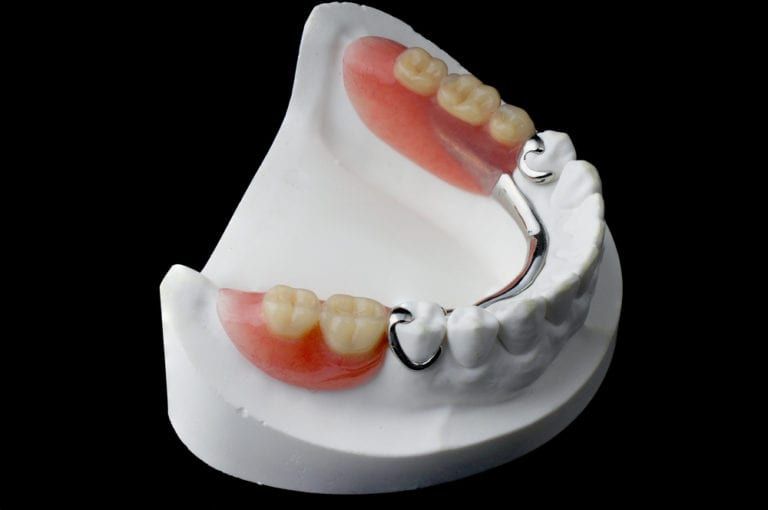
Like a bridge, partial dentures rest on surrounding teeth to fill in the gaps where one or more teeth are missing. But unlike a bridge, partial dentures are fully removable by the wearer. Partials are affordable alternatives to other types of dental prosthetics and are custom-made to blend in with each patient’s natural teeth. It takes a little time to adapt to new partials, but many people find that they reclaim much of their original function and aesthetics with partial dentures in place.
Did you know?
Partial dentures require gentle care and frequent cleaning. Once you get your new partial dentures, you’ll need to:
- Keep them moist at all times by soaking them in a denture solution when not in use
- Gently brush your dentures daily using a soft-bristled tooth brush
- Be careful not to drop your partial dentures, as they may break
- Avoid exposing your partial to hot temperatures that could cause warping
Frequently Asked Questions
Am I a candidate for partial dentures?
You may be a candidate for partial dentures if you have one or more missing teeth, and the space they once filled is surrounded by other teeth or permanent restorations. To find out more about whether partial dentures are right for you, schedule a consultation with your dentist.
What should I expect when being fit for partial dentures?
If you decide to get a partial denture, you’ll need to visit your dentist to have metal clasps attached to your surrounding teeth and an impression made of the area your partial will fill. The impression will be sent to a dental lab, where a technician will fabricate a custom denture that includes a gum-colored base that will fit securely over your gums. A metal framework will be used to attach your new partial to the clasps on your natural teeth to ensure a secure fit.
Will I need to follow any special oral health instructions after receiving my partials?
Yes. Good oral health is still important – even if you have a few missing teeth. In addition to caring for your new dental prosthetic, you’ll also need to brush your gums and tongue twice daily to stimulate circulation and remove bacteria that could cause gum disease. Continue seeing your dentist twice yearly for exams and cleanings, and be sure to bring your partial dentures along to each visit. After a few years, you may find that your partial needs to be rebased to better fit the changes to the bone structure in your mouth.
Removable Dentures
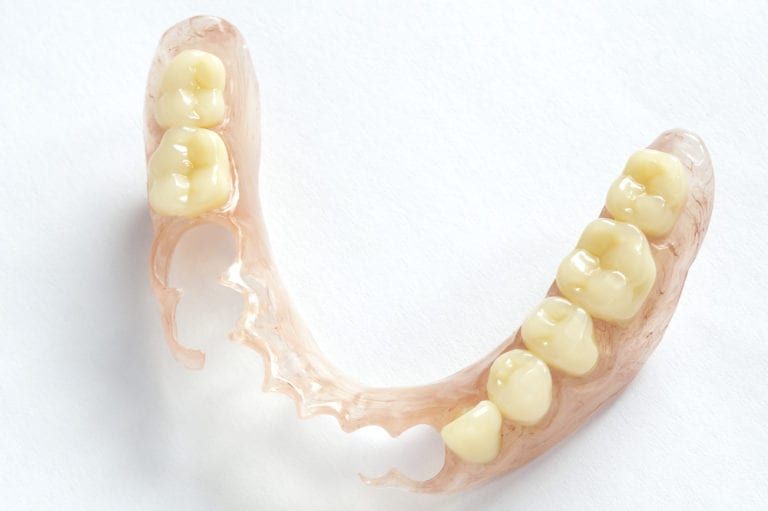
Dentures are removable tooth prosthetics designed to look and function like natural teeth. For thousands of years, some form of denture has been used to fill in the gaps left by missing teeth, although today’s dentures are much more advanced and easier to care for. Most dentures are composed of replacement teeth attached to plastic bases that take on the appearance of the gums. They are used to compensate for one or more missing teeth, and are available as partials and complete sets of teeth. Many dental patients elect dentures for tooth replacement if they are not candidates for dental implants or are otherwise looking for a tooth replacement option that is more affordable and budget-friendly.

Caring for Your Dentures
Your dentures are custom designed to fit your smile, but did you know that improperly caring for them can cause them to become distorted? Most removable dentures must maintain moisture to retain their shape. Be sure to wash them after eating, gently clean them once daily, and allow them to soak overnight in a denture soaking solution. This will keep your dentures clean and free of stains, which ultimately helps your smile look its best.
Dental Health and Your Diet

Your body works hard to convert the foods you eat into energy. You may not think twice about what you are eating – especially when it comes to grabbing an afternoon snack or sipping on a vanilla latte on your commute. But the food you put in your mouth affects more than just your waistline. The truth is, your diet has a direct effect on your overall dental health. Developing good eating habits can lead to excellent oral health free of decay and gum disease. The American Dental Association recommends avoiding certain foods that can expedite decay, such as foods high in sugar.
Did you know…
that eating a slice of pie in the afternoon could be more dangerous to your oral health than eating the same piece of pie as a dessert after dinner? According to the ADA, snacking between meals – especially on sugar-filled foods – can more rapidly lead to decay than eating the same foods with meals. If you must eat the mid-afternoon pie, reach for the toothbrush afterward. Better yet, swap the pie for a nutritious, sugar-free snack like string cheese or some baby carrots.
Frequently Asked Questions
Should I change my eating habits to better my oral health?
Probably. But never start a new diet without first consulting with your physician. If you are on a special diet, be sure to speak with your dentist about the types of foods you should be eating that comply with your diet and can also optimize your oral health.
What types of changes will my dentist recommend?
In addition to avoiding sugary foods, the ADA recommends drinking plenty of water each day and avoiding snacks between meals whenever possible. It is also important to consume nutritious foods from each of the major food groups, including whole grains, vegetables, lean proteins, low-fat dairy, and fruits. Not only will you improve the health of your teeth and gums, but you may drop a pant size too!
Are there any other habits I should be adopting to improve my oral health?
Yes. You should be flossing daily and brushing twice daily using a soft-bristled toothbrush. You should also be visiting your dentist at least twice per year for oral exams and professional dental cleanings.
Bad Breath

Having bad breath can be an embarrassing problem – especially if you are regularly face to face with other people. Known professionally as halitosis, bad breath plagues many people every day. Most cases of bad breath can be remedied by efficiently brushing the teeth. However, some types of bad breath are chronic or recurring, which may warrant a visit to the dentist.

Did you know…
that bad breath can be caused by something as simple as eating too much garlic, or that it could be a serious symptom of a disease? Some of the most common causes of bad breath include dry mouth, certain medications, use of tobacco, poor dental hygiene, and oral infections. In rare cases, bad breath may be a sign of diseases like cancer or gastroesophageal reflux.
Frequently Asked Questions
Do I need treatment for my bad breath?
If your bad breath does not improve despite self-care techniques, such as dietary adjustments and thorough tooth brushing, you may need to see a dentist about pursuing professional treatment. Keep in mind that short-term remedies like gum, breath mints, and mouthwash may temporarily freshen breath, but they are not a solution to the underlying problem.
What should I expect my dentist to do about my bad breath?
Your visit will begin with an examination and questions about your daily habits, such as the types of foods you eat and the medications you take. Your dentist may then inspect your mouth for signs of decay, infections or gum disease that could be causing your bad breath. If your chronic bad breath cannot be traced to an oral problem or daily habit, you may be referred to a physician for further evaluation.
Is there anything I can do to maintain better breath?
Yes. If bad breath is a source of embarrassment for you, try to keep breath fresheners on-hand at all times. Sleep with your mouth closed, as this prevents dry mouth and helps tame morning breath. Eliminate odor-causing foods from your diet, such as garlic and onions, and make an effort to brush your teeth and tongue every morning and night. Finally, be sure to visit your dentist for professional cleanings at least twice per year to remove built-up plaque that can cause chronic halitosis.
How to Brush Your Teeth

Brushing your teeth is probably a standard part of your daily routine, but chances are you aren’t following the American Dental Association’s guidelines for cleaning your teeth properly. The ADA currently recommends that you brush your teeth at minimum of two times each day – preferably morning and night or anytime you eat foods that contain sugar. When you brush, your toothbrush should be tilted at a 45 degree angle to your gum line. As you brush, be sure to remove debris from every surface of the teeth – including the backs of the teeth, near the gum line, and on chewing surfaces. It is also important to brush your tongue, as bacteria can accumulate there and cause bad breath.
Did you know…
that the type of toothbrush you use makes a difference in your oral health? The ADA recommends using a soft-bristled toothbrush with a head that is ergonomically proportioned to the inside of your mouth. Many patients erroneously believe that medium or hard-bristle toothbrushes are more efficient; but these brushes can actually cause abrasions to the teeth and gums, making them more vulnerable to decay. The ADA also recommends replacing your toothbrush about four times yearly or whenever the bristles become frayed, it is also a good idea to change your toothbrush after a cold or virus.
Frequently Asked Questions
Should I change my brushing habits?
You may need to change your brushing habits if you are experiencing signs of poor oral hygiene. Examples of common symptoms include bleeding or reddened gums, excessive plaque build-up, decaying teeth and receding gum lines. To find out if you are brushing correctly or if you need to change your brushing habits, make an appointment with your dentist for a full consultation.
What should I expect if I begin brushing my teeth correct?
The benefits of proper tooth brushing techniques may not be experienced immediately, but they are noticeable long-term. Over time, brushing too hard or not brushing enough can produce oral health complications that cannot be reversed and require special treatment. By adopting proper brushing habits, you could avoid expensive dental bills in the future.
Is there anything else I need to do in addition to brushing properly?
Yes. It is important that you also floss daily and use toothpaste that contains fluoride each day. You should also schedule dental exams and professional cleanings in at least twice a year.
Electric Brush vs. Manual Brushes
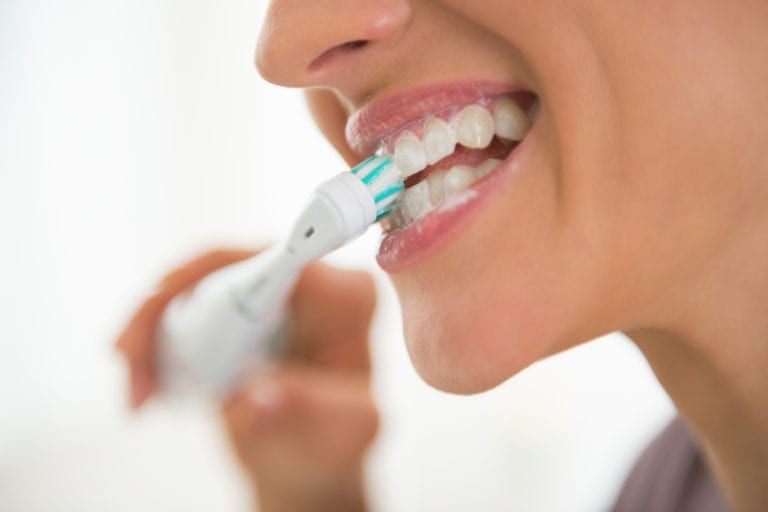
Preventative dentistry is about more than just visiting your dentist twice yearly for an exam and thorough cleaning. In fact, the majority of your preventative care is done at-home as a part of your normal hygienic routine. Many residents use manual toothbrushes to remove debris and plaque from their teeth. However, electric brushes have become widely popular in recent years, leaving some to wonder whether one type is better than the other.
Did you know…
the American Dental Association does not lean toward one type of brush over the other? It does, however, acknowledge that people with upper body mobility restrictions may better benefit from an electric toothbrush instead of a manual brush. Regardless of which type you decide is right for you, the ADA recommends that all brushes be soft-bristled so as to avoid abrasions that can lead to decay and receding gum lines.
Frequently Asked Questions
Which toothbrush should I be using?
You can effectively brush your teeth with either a manual toothbrush or an electric one. However, the rapid movements of motorized versions may be more effective at removing plaque from the teeth and gum line. If you have questions about which toothbrush is best for you, speak with your dentist about it at your next visit. He or she may recommend an electric brush with an oscillating head or a brush that includes a timer to let you know how long to brush.
What types of results should I be getting from by toothbrush?
Regardless of whether you choose an electric brush or a manual brush, it should be easy for you to maneuver in your mouth and behind your back teeth. If the head is too big, it may not be effectively removing plaque from your teeth.
My electric toothbrush was expensive. Do I need to change it as often as a manual brush?
Yes. Your toothbrush should be replaced at least once every three to four months or whenever you notice fraying. However, most electric toothbrushes come with interchangeable heads. In other words, you won’t need to replace the entire device – only the brush itself.
How to Floss Your Teeth
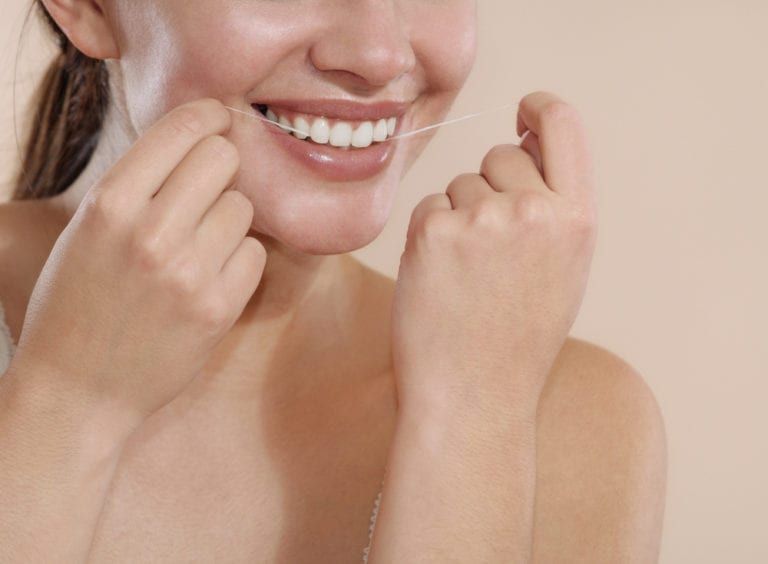
Flossing is an important part of an oral hygiene routine, but research suggests that fewer than half of Americans do so daily. Flossing is simple and only takes an extra couple of minutes per day. Developing a healthy habit of flossing can prevent tooth decay and gum disease, and it may allow you to keep more of your natural teeth as you age. So what is the most effective means of flossing?
- Pull the floss taught and slide it between two teeth.
- Pull against the side of one tooth, creating a “C-shape” and sliding upwards to remove plaque build-up.
- Pull against the opposite tooth edge using the same technique.
- Repeat this process for each tooth until all inner surfaces have been flossed.
- Don’t forget to floss the backs of your molars!
Need some extra tips?
The American Dental Association recommends using a strand of floss approximately 18 inches in length. It is important to only use clean floss as you move between the teeth. One of the easiest ways of doing this is by looping each end of the floss around your fingers and beginning to floss with the area closest to one end. If you have never flossed, be sure to ask your dentist for a quick in-person tutorial at your next check-up.
Frequently Asked Questions
Should I be flossing?
Yes. The ADA recommends that everyone floss in order to prevent tooth decay and gum disease. Even if you have restorations, such as crowns or veneers, good oral hygiene is essential for prolonging their use and maintaining your oral health.
What types of results should I get from flossing?
You may not experience immediate results from flossing, but over time, your habit will pay off. Flossing can prevent tooth decay, gum disease and tooth loss – all of which can be highly inconvenient and expensive to treat. A piece of floss that costs just pennies could save you thousands of dollars later on.
Is there anything else I should be doing in addition to flossing?
Yes. In addition to flossing, you should be adopting proper brushing techniques and visiting your dentist at least twice per year for examinations and professional dental cleanings.
Fluoride and Decay Prevention

Fluoride is a naturally occurring element that has been shown to help strengthen teeth in children and also prevent decay in people of all ages. Topical fluoride helps strengthen enamel and reduce sensitivity. The American Dental Association has publicly endorsed the use of fluoride for the prevention of dental caries, as has the American Academy of Pediatrics and the American Medical Association.
Did you know…
that you might be drinking fluoride every day without knowing it? Many communities add fluoride to the public water supply in an effort to promote better dental health. You can find out if there is fluoride in your tap water by contacting your local water utility. Keep in mind that if your primary source of drinking water is bottled, you may not be getting fluoride. You can contact your bottle water company or manufacturer to find out if fluoride is in your water. If not, speak with your dentist about getting professional fluoride treatments.
Frequently Asked Questions
What should I expect during fluoride treatments?
Fluoride treatments are painless and can be administered in our office at your twice-yearly check-ups and cleanings.
Is there anything I can do to supplement my fluoride treatments?
Yes. The ADA recommends supplementing your fluoridated drinking water with a fluoridated toothpaste.
Dentistry Post-Op Questions

If you are undergoing a dental procedure or operation, you will be given a set of post-operative instructions to abide by in the hours, days, and weeks after your treatment. Following these instructions is essential to preventing infections in surgical sites, protecting restorations, and minimizing the possibility of experiencing complications. Post-operative instructions vary from procedure to procedure, but you are still sure to have some questions regarding care. Your [city] dentist will be available to answer those questions and respond to any concerns you may have.

Try to anticipate some of the questions you may have about your post-operative care and ask them prior to your treatment.
Some of the most common post-op questions include:
-
How should I manage pain following my procedure?
-
How long should I experience discomfort?
-
Do I need to follow any special dietary guidelines?
-
Is it safe for me to drink through a straw?
-
Will I be able to drive myself home after my procedure?
-
Will I need to take an antibiotic?
-
Will I need to return to your office for a follow-up appointment?
-
When will my permanent restorations be ready?
-
How do I care for my removable prosthesis?
Frequently Asked Questions
Should I talk with my dentist about the questions I have regarding my post-operative care?
Yes. Your post-operative care is contingent on you understanding everything about the recovery process and your responsibilities in caring for your surgical site.
What should I expect when I speak with my dentist?
Your dentist should allocate enough time in your consultation and pre-operative exam to listen to your concerns and answer any questions you may have. You should also be provided a phone number that you can call following your procedure to discuss any questions that may come up at that time.
Is there anything I can do to make the process easier?
Yes. Begin thinking of any questions you may have about your post-operative care, and begin writing them down. You’ll be ready to ask all of your questions when the opportunity arises without missing any important details.
TMJ Treatment

TMJ refers to the temporomandibular joint, which is the bone structure, muscles and connective tissues that surround the jaw and control chewing. When patients experience disorders of this joint, they are said to have a temporomandibular joint disorder or TMD. Symptoms of TMD include pain and tenderness near the jaw, as well as popping or clicking in the joint when speaking or chewing. There are many ways of treating TMJ disorders, ranging from non-invasive therapy and bite splints to injections or surgery. Left untreated, however, TMJ disorders can lead to headaches, muscle pain, malocclusion and tooth damage from grinding or clenching.
Did you know…
that TMD alone is not a disorder, but instead a collection of disorders that affect the temporomandibular joint? It is the second most common pain-causing musculoskeletal condition in the U.S. according to the U.S. National Institute of Dental and Craniofacial Research, as many as 12 percent of Americans may suffer from some type of TMD, with women twice as likely to be affected than men. But despite the prevalence and wide availability of treatment, only one out every three people with TMD fails to seek treatment.
Frequently Asked Questions
How do I know if TMJ treatment is right for me?
You will first need to be formally examined and diagnosed with TMJ disorder. You dentist will evaluate the extent of the condition and determine what course of treatment is best for you. Usually, the initial approach involves conservative treatments, such as self-care, physical therapy and bite guards. Medications may also be used to relax the jaw or relieve pain. Patients who do not respond to conservative treatments may be considered for surgery or joint injections.
What should I expect if I undergo treatment for TMJ
TMJ treatment varies from patient to patient, so your experience may be very different than someone else’s. You’ll probably be asked to adopt certain lifestyle changes to help facilitate rehabilitation in your jaw. For example, you may be asked to avoid sudden jaw movements, such as yelling or yawning. You may also need to begin sleeping on your back and take steps to reduce your stress levels.
Will I need to follow any special post-care instructions while being treated for TMJ?
Your post-treatment care instructions will vary according to the type of treatment you receive. If you undergo an aggressive treatment, such as surgery, you may be temporarily subject to an all-liquid diet. You’ll also need to apply ice to the face to minimize swelling and also keep the surgical site clean and dry.
Veneers
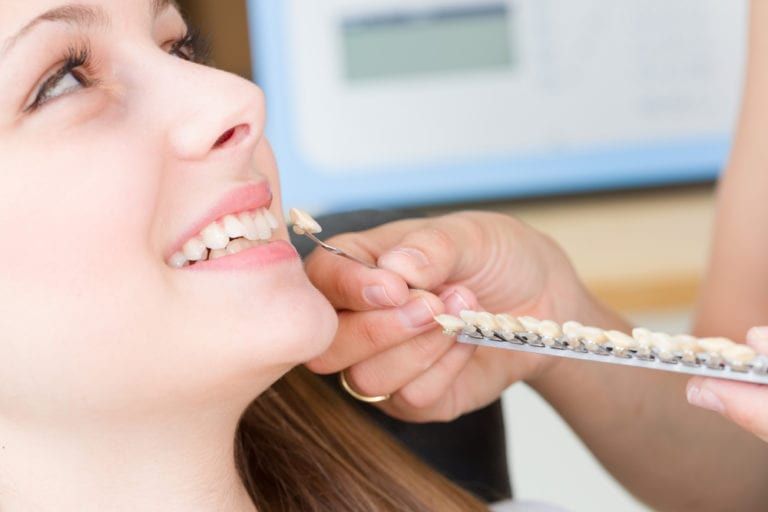
Dental veneers – also known as laminates – are used to cosmetically enhance the appearance of one or more teeth. Veneers are very thin, porcelain or resin shells that are customized for a desirable color and shape. They are bonded to the surface of the teeth to reshape broken, misshapen or irregular teeth. Patients with veneers typically achieve a natural tooth appearance that is well-tolerated by the gums and also resistant to future stains.
Did you know…
that dental veneers are a conservative way of completely making over your smile? In fact, veneers are a go-to cosmetic procedure that has become popular with celebrities who want a brighter and more symmetrical smile. Miley Cyrus, Hilary Duff and Ben Affleck are just some of Hollywood’s elite who have seen a cosmetic dentist for laminates. Fortunately, affordability and accessibility make it easy for anyone to get dental veneers – including patients.
Frequently Asked Questions
Am I a candidate for veneers?
Dental veneers may be right for you if you are looking for an alternative to crowns and caps. Veneers can help you if you have gaps between your teeth or teeth that are broken, chipped, irregularly shaped or misaligned. To find out more about whether veneers are right for you, contact our office at 515.279.0926 to schedule a consultation.
Teeth Whitening
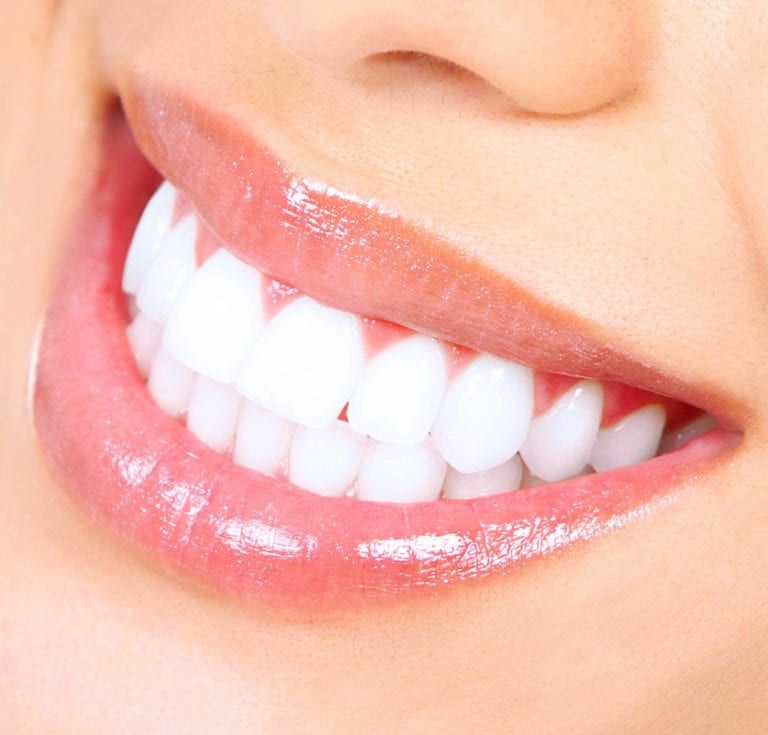
Teeth whitening procedures are used to brighten the appearance of a patient’s smile – sometimes by as many as 5 to 10 shades in a single session. According to the American Dental Association, teeth whitening procedures have become some of the most popular esthetic dental treatments among patients throughout the country, including. Professional teeth whitening services can be performed in an office setting or prescribed for take-home use by a patient. In comparison to over-the-counter teeth whitening treatments, professional whitening uses stronger whitening agents that deliver faster and more effective results.
Did you know…
that the teeth naturally darken as we age? Furthermore, certain foods, beverages, medications and habits can contribute to a darker, yellowed, or stained smile. However, it is possible to erase years of stains in a single professional whitening session and sustain those results for many years with proper maintenance. According to the American Academy of Cosmetic Dentistry, professional whitening is best maintained by a combination of good oral care and take-home whitening treatments as recommended by your dentist.
Frequently Asked Questions
Am I a Candidate for Teeth Whitening?
You may be a candidate for professional teeth whitening if you are experiencing discoloration, but otherwise have healthy teeth and healthy gums. Schedule a consultation with a dentist to find out if tooth whitening could be right for you. Some patients, such as those who are pregnant or sensitive to whitening agents, may not be candidates for professional whitening.
What Should I Expect When I Get My Teeth Whitened?
Teeth whitening consists of a thorough cleaning and polishing of the teeth, with all debris carefully removed. Your dentist will then protect your gums before applying a whitening agent to the surface of your teeth. The product will be activated and left on the teeth for several minutes before being washed off with water. Your results will vary according to the natural shade of your teeth and degree of discoloration, but it is normal for patients to experience a lightening of several shades in a single visit.
What Type of Post-Treatment Care is Required After Having My Teeth Whitened?
It is normal to experience some tooth sensitivity following a professional whitening treatment. You may be instructed to avoid consuming highly pigmented beverages for at least 24 hours to prevent the teeth from becoming stained again. Examples include tea, coffee and wine. Depending on your results and long-term teeth whitening goals, you may also be sent home from your procedure with an at-home whitening kit for later use.
Smile Gallery






General Dentistry
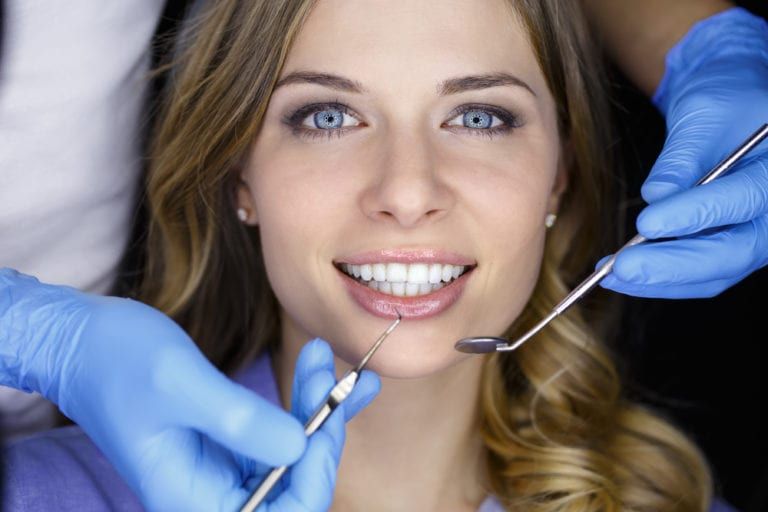
General dentistry encompasses a broad range of diseases and disorders of the oral and maxillofacial region. Everyone should see a general dentist for routine oral health examinations, twice-yearly cleanings, and treatment of routine oral health complications, such as minor tooth decay. General dentistry is as much about prevention as it is about treatment. Patients who visit a general dentist can expect professional oral health care, as well as education and advisement about self-care between office visits.

Did you know…that the American Dental Association recommends that every American visit a general dentist a minimum of one time every six months? Doing so can aid in the detection of decay, oral disease and other dental health problems before the progress and become severe. If you are at risk for certain complications or have a history or periodontal disease and advanced decay, you may need to visit your general dentist on a more frequent basis. Patients who visit their dentist regularly and as recommended are more likely to retain their natural teeth and enjoy a lifetime of good oral health.
Do I need to visit a general dentist?Frequently Asked Questions
Yes. Even if you are not currently experiencing any symptoms of tooth decay or gum disease, it is important to visit your dentist for a thorough examination and cleaning. Despite daily brushing and flossing, your teeth can still accumulate tartar that can harbor bacteria. These bacteria can lead to gum disease and tooth decay if not professionally removed at your dentist’s office.
What should I expect during my dentist visit?
Your visit will begin with a general inspection of the condition of your teeth. If you have not been to the dentist in a while, your dentist may order x-rays. An oral hygienist will then use special metal instruments to gently scrape away tartar along your gum line. Later, your dentist will review your x-rays and discuss any symptoms you may have been experiencing. He or she will then make a recommendation for treatment (if applicable) and answer any questions you may have.
Are there any special instructions I need to follow after seeing my dentist?
Based on the results of your dental check-up, your general dentist may recommend that you return for treatment or follow a special at-home oral care plan. You may also be referred to a dental specialist for treatment of advanced oral health conditions.
Cosmetic Dentistry
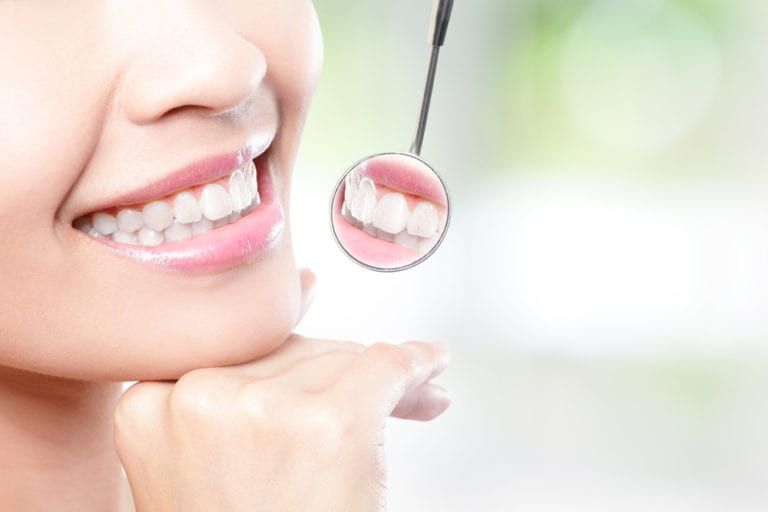
Your smile is the first impression that others have of you, so it makes sense that you would want it to be bright, white and healthy. According to the American Academy of Cosmetic Dentistry, more than 99 percent of all American adults believe that a smile is an important asset for social situations. Perhaps that is why so many patients are electing cosmetic dental procedures to improve their smiles and boost self-confidence.
Did you know…
that cosmetic dentistry is more than just teeth whitening? Your cosmetic dentist is also capable of transforming your smile’s shape, color, alignment, as well as filling in gaps and discreetly restoring decayed or damaged teeth with tooth-colored fillings. In fact, modern advancements in cosmetic dentistry have made it possible for patients to achieve nearly perfect teeth with cosmetic enhancements and restorations that are virtually undetectable to friends, family and peers.
Frequently Asked Questions
Am I a candidate for cosmetic dentistry?
You may be a candidate for cosmetic dentistry if your healthy teeth have imperfections that you would prefer to be changed to enhance the appearance of your smile. It is important to recognize that esthetic dental treatments are not meant to alter your overall appearance, but rather to provide a positive change that compliments the health and natural appearance of your teeth. If you think cosmetic dentistry is right for you, contact your cosmetic dentist today to schedule a consultation.
What should I expect from my cosmetic dental visit?
Due to great strides in dentistry, cosmetic, restorative and general dentistry can overlap in a single visit. You can expect your cosmetic dentist to discuss health implications, as well as esthetics at your appointment.
What types of cosmetic treatments are available to me?
There are many types of cosmetic treatments available, from in-office teeth whitening to total smile make-overs. The types of treatments available to you will depend on your overall goals, but may include professional whitening, tooth-colored fillings, bonding, crowns, veneers, or dental implants.
What should I expect after receiving a cosmetic treatment?
You will receive special care instructions following your treatment. For example, if you have your teeth whitened you should avoid highly pigmented beverages and foods for several days to prevent staining. On the other hand, a dental implant make-over may require a significant amount of down time, as well as a temporary, but limited diet.
Sports Mouth Guard

Dental mouth guards have long been used to protect the teeth, gums and supporting tissues from damage, injury and trauma. There are two types of sports mouth guards – over the counter and custom. While OTC guards are helpful for occasional use, many dental patients require the benefit of a customized dental mouth guard fitted by a dentist to effectively prevent injury.
Caring for your new custom mouth guard is simple.
The American Dental Association recommends keeping protected in a sturdy container in between usage. You should also be careful to clean your mouth guard after use and occasionally soak it in cool, soapy water for thorough sanitation. Custom dental mouth guards are designed for durability, but it is important to check your mouth guard for signs of wear every few months. Mouth guards for children and teens must be replaced frequently to account for growing jaws and changes to the teeth.
Frequently Asked Questions
Do I need a dental mouth guard?
There are many reasons why wearing a dental mouth guard could be right for you. A few examples include:
- Nighttime wear to prevent damage from teeth grinding and bruxism
- Tooth and lip protection during high-impact sports, such as martial arts
- To serve as a barrier between the lips and oral appliances, such as metal braces
- To protect fragile bridgework
What should I expect when my dentist fits me for a mouth guard?
Your visit will consist of taking an impression of your teeth that will be used as a mold for your new mouth guard. You may even be able to leave your dental appointment with your custom mouth guard in-hand.
Should I follow any special instructions?
Before you leave your dentist’s office with your new mouth guard, you’ll receive instructions on how and when to wear it. If you suffer from TMJ disorders or bruxism, for example, you will likely wear your mouth guard at night. If you participate in recreational sports, however, you may only need to wear your mouth guard during physical activity.
Dental X-Rays
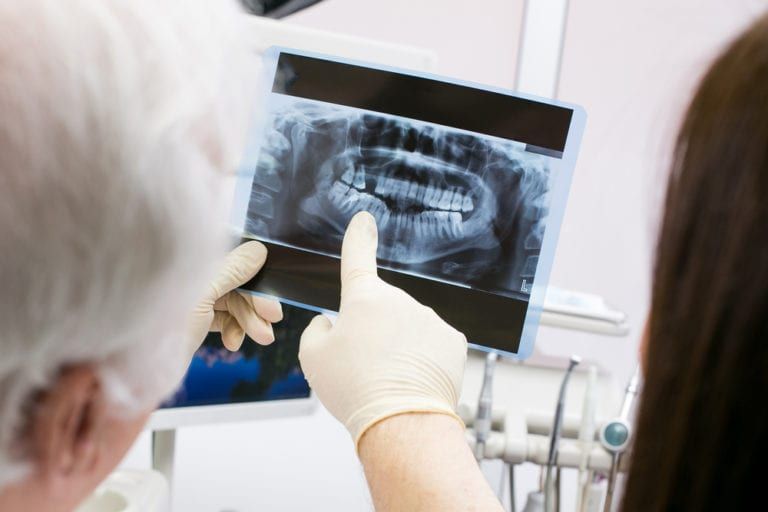
For years, dental x-rays have been used to diagnose oral health complications and detect decaying or damaged teeth. X-rays provide a unique view of the mouth that isn’t possible with a visual exam alone. When x-rays are taken, the teeth and bones absorb the majority of the ray, making them highly visible on film or on a screen. Nearly all new dental patients are x-rayed, although you may instead request that previous x-rays be transferred from another dental provider to your new dentist. By comparing your x-rays with your full mouth examination and dental history, your dentist can prescribe effective treatment and recommend a plan for preventative care.
Did you know…
that dental x-rays deliver very low levels of radiation and are considered completely safe? In fact, x-rays are even considered safe during pregnancy and while breastfeeding so long as a leaded apron and collar are used to protect your body from exposure. If you are pregnant or think you may be, tell your dentist so proper precautions can be taken.
Frequently Asked Questions
Should I get dental x-rays?
Yes. Dental x-rays are capable of identifying tooth decay and damage beneath the surface of the teeth where caries are less visible during an examination. Furthermore, x-rays provide a reference point for the progression of decay in your mouth over time. You should have x-rays taken on a regular basis, but especially if you are experiencing oral health complications or are planning to undergo a dental procedure, such as a root canal.
What should I expect when I get dental x-rays?
Getting traditional dental x-rays can take several minutes. A thick paper tab is placed into the mouth, which you will be asked to bite down on. Most patients find that dental x-rays are completely painless and do not inflict any level of discomfort. In some cases, dentists intraoral x-rays, as well as extra-oral x-rays that snap images of the face, jaw and skull. Extra-oral x-rays are typically used to identify impacted teeth, such as wisdom teeth.
What happens after my dentist has taken x-rays?
Your x-rays will be saved either on film or digitally. In the future, your dentist may request additional dental x-rays every few years to monitor the health of your teeth, gums and jaw over time. If you are considered to be high risk for oral disease or are exhibiting symptoms of complications, your dentist may prefer to take x-rays more frequently.
Digital X-Rays
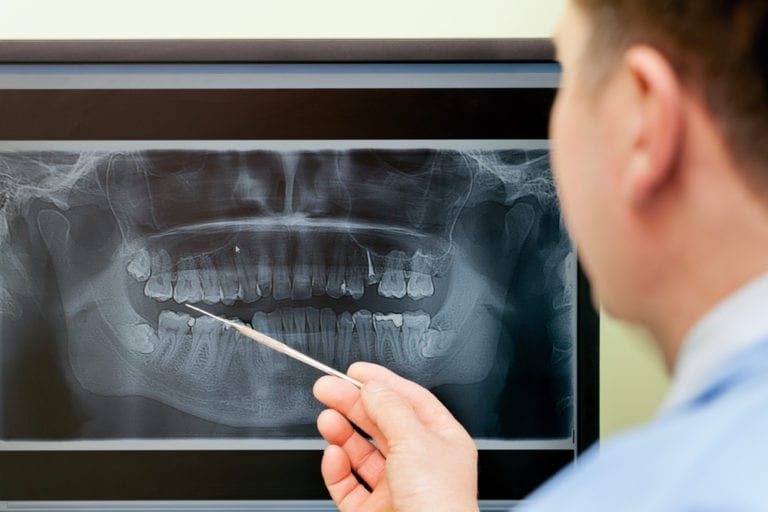
Digital x-rays are a more streamlined way of taking dental radiographs. Like traditional x-rays, digital versions provide an in-depth view of the structures of the mouth, helping dentists detect complications and develop effective modes of treatment. Digital x-rays are capable of revealing hidden caries, bone erosion, and even tooth decay hiding beneath restorations.
Requiring less radiation and no film to process, digital x-rays have become the standard for oral imaging. These systems produce instant digital images that can easily be enhanced and enlarged for a more accurate diagnosis. The images are captured, stored, and even transmitted via in-office computers. In fact, dentists can easily print or email copies of x-rays in just seconds.
Dental x-rays make for a better and more efficient patient experience. Office visits are faster, patients are exposed to less radiation, and radiographs can be sent to a specialist for review in a fraction of the time necessary for traditional film x-rays.
Hello world!
Welcome to 360sites.net. This is your first post. Edit or delete it, then start blogging!
